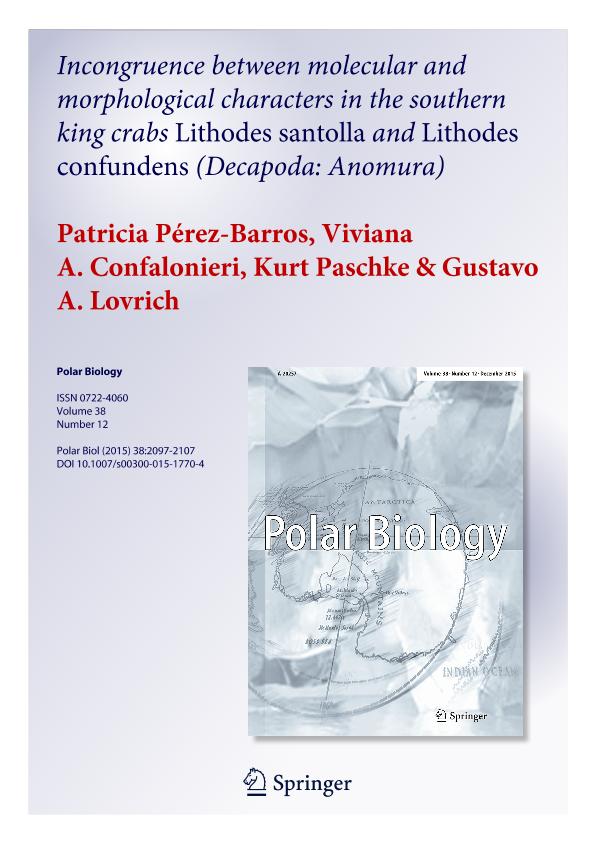Mostrar el registro sencillo del ítem
dc.contributor.author
Pérez Barros, Patricia

dc.contributor.author
Confalonieri, Viviana Andrea

dc.contributor.author
Paschke, Kurt
dc.contributor.author
Lovrich, Gustavo Alejandro

dc.date.available
2019-10-07T18:40:45Z
dc.date.issued
2015-12
dc.identifier.citation
Pérez Barros, Patricia; Confalonieri, Viviana Andrea; Paschke, Kurt; Lovrich, Gustavo Alejandro; Incongruence between molecular and morphological characters in the southern king crabs Lithodes santolla and L. confundens (Decapoda: Anomura); Springer; Polar Biology; 38; 12; 12-2015; 2097-2107
dc.identifier.issn
0722-4060
dc.identifier.uri
http://hdl.handle.net/11336/85297
dc.description.abstract
The use of genetic tools has a relevant role in fishery resource management and conservation, for example, when used in species delimitation. Morphological variation can occur as an adaptative or plastic response to environmental variation, and therefore, be mistakenly used as a criterion to delimit species. Particularly, Lithodes santolla and Lihodes confundens, two commercially important lithodid species from sub-Antarctic South America, are mainly differentiated by the number and size of spines on the carapace and pereiopods. However, variability in the size of spines of L. santolla has been reported. We evaluated whether these two morphospecies constitute reciprocally monophyletic clades at the molecular level using mitochondrial markers, and performed a detailed morphological analysis of the carapace to search for correspondence between genetic and morphological differences. The Bayesian phylogenetic reconstruction showed that L. santolla and L. confundens belong to two sister clades. However, individuals identified as L. santolla and L. confundens did not resolve as reciprocally monophyletic groups. Instead, one clade was formed by individuals belonging to both morphospecies and was widely distributed, while the other one was exclusively formed by L. santolla, and its members were only found near Puerto Montt and in the Beagle Channel. No morphological characters were found on the carapace that could differentiate individuals belonging to each genetic clade. Either if the two genetic clades constitute species or remnants of two species that are merging through introgression, they represent two evolutionary significant lineages, and measures should be taken to preserve both. Our study suggests the need to revise the use of the number of spines as a relevant taxonomic character in the taxonomy of Lithodes, and to implement molecular genetic methods to control fisheries.
dc.format
application/pdf
dc.language.iso
eng
dc.publisher
Springer

dc.rights
info:eu-repo/semantics/openAccess
dc.rights.uri
https://creativecommons.org/licenses/by-nc-sa/2.5/ar/
dc.subject
16S
dc.subject
BURDWOOD BANK
dc.subject
CENTOLLA
dc.subject
COI
dc.subject
LITHODIDAE
dc.subject
SPECIES DELIMITATION
dc.subject.classification
Biología Marina, Limnología

dc.subject.classification
Ciencias Biológicas

dc.subject.classification
CIENCIAS NATURALES Y EXACTAS

dc.title
Incongruence between molecular and morphological characters in the southern king crabs Lithodes santolla and L. confundens (Decapoda: Anomura)
dc.type
info:eu-repo/semantics/article
dc.type
info:ar-repo/semantics/artículo
dc.type
info:eu-repo/semantics/publishedVersion
dc.date.updated
2019-10-04T18:39:06Z
dc.identifier.eissn
1432-2056
dc.journal.volume
38
dc.journal.number
12
dc.journal.pagination
2097-2107
dc.journal.pais
Alemania

dc.journal.ciudad
Berlin
dc.description.fil
Fil: Pérez Barros, Patricia. Consejo Nacional de Investigaciones Científicas y Técnicas; Argentina. Universidad Maimónides. Área de Investigaciones Biomédicas y Biotecnológicas. Centro de Estudios Biomédicos, Biotecnológicos, Ambientales y de Diagnóstico; Argentina
dc.description.fil
Fil: Confalonieri, Viviana Andrea. Consejo Nacional de Investigaciones Científicas y Técnicas. Oficina de Coordinación Administrativa Ciudad Universitaria. Instituto de Ecología, Genética y Evolución de Buenos Aires. Universidad de Buenos Aires. Facultad de Ciencias Exactas y Naturales. Instituto de Ecología, Genética y Evolución de Buenos Aires; Argentina
dc.description.fil
Fil: Paschke, Kurt. Universidad Austral de Chile; Chile
dc.description.fil
Fil: Lovrich, Gustavo Alejandro. Consejo Nacional de Investigaciones Científicas y Técnicas. Centro Austral de Investigaciones Científicas; Argentina
dc.journal.title
Polar Biology

dc.relation.alternativeid
info:eu-repo/semantics/altIdentifier/url/https://link.springer.com/article/10.1007/s00300-015-1770-4
dc.relation.alternativeid
info:eu-repo/semantics/altIdentifier/doi/https://doi.org/10.1007/s00300-015-1770-4
Archivos asociados
